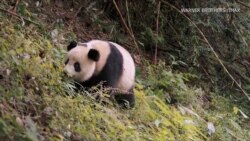The giant panda is an icon in China. But fewer than 2,000 remain in the wild, most of them in the mountains of China's Sichuan, Shaanxi and Gansu provinces.
Scientists at the Chengdu Panda Base in Sichuan province have been working for years to increase the captive panda population. Now a new documentary, called Pandas, tells of a program to introduce some of those cubs into the wild.
WATCH: US, Chinese Scientists Work Together to Reintroduce Pandas to Wild
Black bear example
Wildlife biologist Huo Rong from Chengdu worked with naturalist and author Ben Kilham, who specializes in releasing orphaned black bears into the wild.
“Huo Rong has been here to visit a couple times and met the black bears," Kilham said. "It was her first trip here meeting the black bear cubs that made her realize that this could be done with pandas."
The film shows how Huo Rong, Kilham and American wildlife biologist Jake Owens worked to choose and prepare a female panda cub named Qian Qian.
The film was written and co-directed by Drew Fellman, who had been working with Global Cause Foundation, a U.S.-based nonprofit that works alongside the Chengdu panda research base to save the endangered animals.
Fellman was familiar with Kilham's work with black bears and wanted to document his work with pandas. The filmmaker told VOA his first challenge was to build the trust necessary among the participants for the film to be shot.
“We had to gain their trust and also they had to gain our trust a little bit as well," Fellman said. "You know, we wanted to make sure that they would actually give us the access that we needed to make the film and they wanted to make sure that we would tell their story honestly."
For two years, wildlife biologist Owens worked with Qian Qian in the bamboo forests of Chengdu. Eventually, the day came when she left the captive panda enclosure for the first time. Owens told VOA that building the team and working with the Chinese scientists had one goal: helping to increase the number of wild pandas.
“That’s the whole point of this project is to get pandas that are born from captive-born mothers and born in a human care facility and then get them to transition out into the wild,” Owens said.
IMAX Format
Pandas is shot in IMAX 3-D, which co-director Fellman says puts audiences in the action.
"We want to bring the audience into the environment so you have the same experience the scientists do working with the pandas. You're not just looking at pandas, you feel like you're in the space with them," he said.
Owens says the project is ongoing and he hopes the film inspires others to work to save endangered species.
"I think it shows the kind of opportunities that are available," he said. "For young kids to get excited and really be in the film -- hopefully people will see 'oh this is something exciting and interesting and I'd like to get into it and save some other species," he added.
The film opens in U.S. IMAX theaters on April 6.







